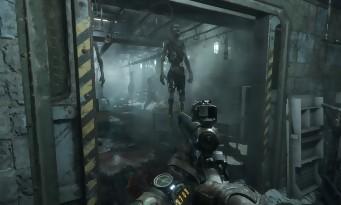 After the events of Metro Last Light, life goes on in Moscow's metro corridors. But far from being content with this reclusive life, Artyom regularly goes to confront the mutated creatures on the surface, with the aim of finding other survivors there. Naturally, he will end up discovering signs of life, and even finds himself fleeing on board a train, with Anna, his sniping wife, and a few other faithful traveling companions. We will not give you much more details regarding the scenario, because the adventure has a little twist in store for you from its first minutes. No surprise, however, in terms of graphics: just like its predecessors, Metro Exodus remains a standard meter in this area. Artyom's first encounter with a Howler should convince you of that, with the creature's keen eye alone proving the attention to detail that seems to have guided the developers. The diffusion of light and the weather effects are not left out, the game regularly offering us absolutely splendid panoramas.
After the events of Metro Last Light, life goes on in Moscow's metro corridors. But far from being content with this reclusive life, Artyom regularly goes to confront the mutated creatures on the surface, with the aim of finding other survivors there. Naturally, he will end up discovering signs of life, and even finds himself fleeing on board a train, with Anna, his sniping wife, and a few other faithful traveling companions. We will not give you much more details regarding the scenario, because the adventure has a little twist in store for you from its first minutes. No surprise, however, in terms of graphics: just like its predecessors, Metro Exodus remains a standard meter in this area. Artyom's first encounter with a Howler should convince you of that, with the creature's keen eye alone proving the attention to detail that seems to have guided the developers. The diffusion of light and the weather effects are not left out, the game regularly offering us absolutely splendid panoramas.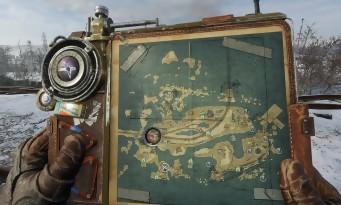 Technically and artistically, we can only bow. The care taken in the realization extends to secondary aspects, which other studios would have simply neglected. The cracks and dirt on the glass of the gas mask, the fact that you can wipe it off with the back of your hand, or even the spiders that run on the screen if you don't burn their webs are again part. And the interface is almost entirely diegetic, à la Dead Space. In other words, most of the information is not stupidly displayed on the screen, but integrated into Artyom's suit (Geiger counter, compass indicating the direction of the next main objective, remaining duration of filters for the gas mask, etc.). As for the map of the surroundings, it is materialized by a real object in the game, which Artyom can return to read the current objective, presented in the form of handwritten notes. The result is clear: most of the time, no unsightly HUD pollutes the screen.
Technically and artistically, we can only bow. The care taken in the realization extends to secondary aspects, which other studios would have simply neglected. The cracks and dirt on the glass of the gas mask, the fact that you can wipe it off with the back of your hand, or even the spiders that run on the screen if you don't burn their webs are again part. And the interface is almost entirely diegetic, à la Dead Space. In other words, most of the information is not stupidly displayed on the screen, but integrated into Artyom's suit (Geiger counter, compass indicating the direction of the next main objective, remaining duration of filters for the gas mask, etc.). As for the map of the surroundings, it is materialized by a real object in the game, which Artyom can return to read the current objective, presented in the form of handwritten notes. The result is clear: most of the time, no unsightly HUD pollutes the screen.
METRO, BRICO, DODO
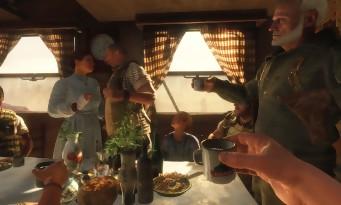 There are still one or two exceptions to this rule, such as the ability to display the weapons and ammunition that we have, or the manipulations performed on the workbenches. But it is rather for the good cause, since this last point allows the player to fully customize the weapons, thanks to dozens of accessories ranging from the charger to the telescope, through this or that type of handle. It is also possible to craft new ammunition and clean weapons (grime visibly piles up on them over time) to improve their performance. All these operations are carried out using material and chemical components that are recovered from the environment. Pneumatic weapons, which must be recharged by increasing their pressure, once again answer the call and also enrich the gameplay of the fights. Metro Exodus also likes to encourage the player to choose the path of infiltration, which is always optional since a failure in this area simply results in the outbreak of more direct confrontations. But it is often preferable to turn off the various light sources, defuse the traps and stun the enemies by approaching them from behind in order to pass unnoticed in certain sections of the levels. The scenario even regularly provides a justification for leniency, for example by emphasizing that our adversaries are slaves that it would be fairer to spare. However, you can do as you see fit, but be aware that some of your decisions will sometimes have consequences on the future of your companions, and on the end of the adventure.
There are still one or two exceptions to this rule, such as the ability to display the weapons and ammunition that we have, or the manipulations performed on the workbenches. But it is rather for the good cause, since this last point allows the player to fully customize the weapons, thanks to dozens of accessories ranging from the charger to the telescope, through this or that type of handle. It is also possible to craft new ammunition and clean weapons (grime visibly piles up on them over time) to improve their performance. All these operations are carried out using material and chemical components that are recovered from the environment. Pneumatic weapons, which must be recharged by increasing their pressure, once again answer the call and also enrich the gameplay of the fights. Metro Exodus also likes to encourage the player to choose the path of infiltration, which is always optional since a failure in this area simply results in the outbreak of more direct confrontations. But it is often preferable to turn off the various light sources, defuse the traps and stun the enemies by approaching them from behind in order to pass unnoticed in certain sections of the levels. The scenario even regularly provides a justification for leniency, for example by emphasizing that our adversaries are slaves that it would be fairer to spare. However, you can do as you see fit, but be aware that some of your decisions will sometimes have consequences on the future of your companions, and on the end of the adventure.
THE BATTLE OF THE RAIL
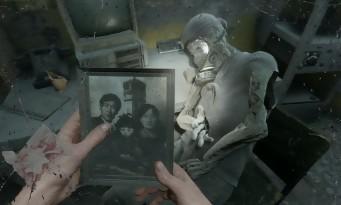 So far, Metro Exodus might seem like just one more Metro, and nothing else. But that would be to disregard Aurora, the locomotive that transports Artyom and his friends. Thus, the story adopts the structure of a road movie, or rather a rail movie, and takes us through Russia to the rhythm of the different seasons of the year. Several stops are planned, and each of them takes the form of a small open world, which offers many main and secondary objectives. The player has every interest in regularly taking out his binoculars, in order to mark the different singular places on the map. Some will turn out to be simple enemy hideouts, which can be cleared to recover material, and others will be much more important, whether in terms of their size, the care taken in their modeling, or their importance. screenplay. The game offers a few vehicles to shorten certain journeys, but their presence remains relatively anecdotal.
So far, Metro Exodus might seem like just one more Metro, and nothing else. But that would be to disregard Aurora, the locomotive that transports Artyom and his friends. Thus, the story adopts the structure of a road movie, or rather a rail movie, and takes us through Russia to the rhythm of the different seasons of the year. Several stops are planned, and each of them takes the form of a small open world, which offers many main and secondary objectives. The player has every interest in regularly taking out his binoculars, in order to mark the different singular places on the map. Some will turn out to be simple enemy hideouts, which can be cleared to recover material, and others will be much more important, whether in terms of their size, the care taken in their modeling, or their importance. screenplay. The game offers a few vehicles to shorten certain journeys, but their presence remains relatively anecdotal.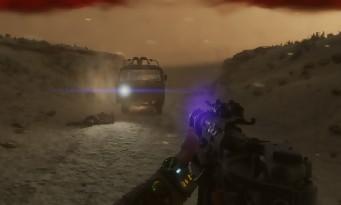 We can also find caches here and there with workbenches, just to do a little crafting between two missions, and beds. Metro Exodus indeed manages a real day/night cycle and gives us the opportunity to sleep as much as we want, in order to be able to fulfill certain day or night missions, as desired. In the first case, we will tend to come across more bandits, and in the other more monstrous creatures. The story missions will prove to you that sometimes it's humans who can pose the most horrific threats. Certain groups of survivors would not go wrong in The Walking Dead… The universe is therefore more murky and crazy than ever, the open world then allowing you to afford a few breaths of fresh air. The fact of visiting very different places through the four seasons of the year brings a great variety to the game, in terms of decorations as bestiary. Facing giant crustaceans on the edge of a snowy lake or sand creatures in the desert, neither Metro 2033 nor Metro Last Light could offer it to us.
We can also find caches here and there with workbenches, just to do a little crafting between two missions, and beds. Metro Exodus indeed manages a real day/night cycle and gives us the opportunity to sleep as much as we want, in order to be able to fulfill certain day or night missions, as desired. In the first case, we will tend to come across more bandits, and in the other more monstrous creatures. The story missions will prove to you that sometimes it's humans who can pose the most horrific threats. Certain groups of survivors would not go wrong in The Walking Dead… The universe is therefore more murky and crazy than ever, the open world then allowing you to afford a few breaths of fresh air. The fact of visiting very different places through the four seasons of the year brings a great variety to the game, in terms of decorations as bestiary. Facing giant crustaceans on the edge of a snowy lake or sand creatures in the desert, neither Metro 2033 nor Metro Last Light could offer it to us.
STRUCTURE OF THE ARTYOM
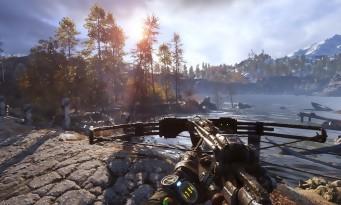 But the transition to the semi-open world has both advantages and disadvantages. The adventure gains in variety what it sometimes loses in personality. Some passages against desert bandits are a little too reminiscent of Rage or Borderlands. And above all, if the progression is much less linear than before, you have to do in return with a less controlled rhythm. The player has to deal with a lot of downtime, especially when it comes to getting from one point of interest to another. The movements sometimes seem a little long, especially since the music seems to be reserved for the combat sequences. A few generic loops to accompany the quieter moments wouldn't have hurt. The developers have tried to add long monologues and dialogues between NPCs in certain places, just to breathe life into the world, and thus distill some lore information in the middle of more or less banal words. But suddenly, the player who does not want to miss anything finds himself regularly planted like a picket doing nothing, apart from listening for too long minutes of the characters talking to each other. In addition, Artyom remains desperately silent when spoken to, which tends to break the immersion a bit. Incidentally, note that the English voices are played with a Russian accent, while the French version ignores this refinement. In the end, the game's biggest flaws obviously stem from a lack of experience with open worlds. We feel that the series is working on it for the first time but, fortunately, this does not spoil the experience beyond measure. We get used to the few moments of hesitation fairly quickly, and the adventure has many highlights in store for us, which largely play in its favour.
But the transition to the semi-open world has both advantages and disadvantages. The adventure gains in variety what it sometimes loses in personality. Some passages against desert bandits are a little too reminiscent of Rage or Borderlands. And above all, if the progression is much less linear than before, you have to do in return with a less controlled rhythm. The player has to deal with a lot of downtime, especially when it comes to getting from one point of interest to another. The movements sometimes seem a little long, especially since the music seems to be reserved for the combat sequences. A few generic loops to accompany the quieter moments wouldn't have hurt. The developers have tried to add long monologues and dialogues between NPCs in certain places, just to breathe life into the world, and thus distill some lore information in the middle of more or less banal words. But suddenly, the player who does not want to miss anything finds himself regularly planted like a picket doing nothing, apart from listening for too long minutes of the characters talking to each other. In addition, Artyom remains desperately silent when spoken to, which tends to break the immersion a bit. Incidentally, note that the English voices are played with a Russian accent, while the French version ignores this refinement. In the end, the game's biggest flaws obviously stem from a lack of experience with open worlds. We feel that the series is working on it for the first time but, fortunately, this does not spoil the experience beyond measure. We get used to the few moments of hesitation fairly quickly, and the adventure has many highlights in store for us, which largely play in its favour.


























